NYU�s Courant Institute Celebrates 75th Anniversary
July 15, 2011
In 1936, Richard Courant, founder and sole faculty member of the new Graduate Center for Mathematics at New York University, was devoting much of his time and considerable energy to fund raising. The objective, as described by the late Constance Reid in her 1976 biography of Courant, was to build at NYU an institute modeled on the one he had created at G�ttingen, "a place where no distinction was made between mathematics and its applications and where advanced students and faculty were like a family."
On May 6 and 7, the center, long since renamed the Courant Institute of Mathematical Sciences, held a two-day symposium to celebrate its 75th anniversary. Realizing the impossibility of recognizing everything the Courant Institute has become, the organizers seem to have set out simply to hold the kind of symposium they would like to attend. On the first day, devoted to technical and quasi-technical talks, Courant faculty and a few visitors discussed current work. Courant director Leslie Greengard opened the program with a talk titled "Fast Algorithms and Potential Theory in Scientific Computing." (In September, on completion of five years as director, Greengard will step down; his successor, G�rard Ben Arous, has been a professor of mathematics at Courant since 2002.)
Also on the program was Nick Trefethen, who as president of SIAM was introduced by Greengard as "our commander-in-chief," and whose direct connection to Courant was as a postdoc early in his career (1982�84). "So many have passed through, and it changed our lives," Trefethen said, pointing out that his work, quite theoretical in the early days, has steadily become more applied. He titled his talk "Robust Rational Interpolation, Pad� Approximation, and Extrapolation of Sequences."
Courant computer scientist Dennis Shasha, known as a colorful speaker (and writer), may have been thinking of the early unprepossessing graduate center in a fascinating talk, "The Changing Nature of Invention in Computer Science," in which he profiled people like John Backus whose groundbreaking work arose from unpromising beginnings.
In addition to being delighted, Richard Courant would surely have been amazed by much of the 75th-anniversary symposium. In particular, he might have been surprised by the topics discussed in the second day's panel sessions. Quoting him in the biography, Constance Reid wrote of his vision of the institute as "a strong and many-sided institution" which not only "carries on research and educational work . . . in pure and abstract mathematics, but also emphasizes the connection between mathematics and other fields, such as physics, engineering, possibly biology and economics, and which cooperates in helping to develop better standards in high school instruction."
The program for the second day of the symposium consisted of eight one-hour panel sessions in application areas important to the Courant Institute: Games for Learning; Atmosphere & Ocean Science; Mathematics, Biology, and Medicine; Technology and Economic Development; The Future Role of Financial Markets; Human vs Machine 2011: Recent Trends in A.I., Turing Tests, Uncanny Valleys, and Wisdom of Crowds; Mathematics and Experiment; and Computational Biology, Genomics, and Bioinformatics.
If something of the spirit of the Courant Institute was apparent at the symposium, it was even more present in the 15-minute documentary film made for the anniversary and shown during the symposium. Current faculty and postdocs (all the accompanying photos and quotes are from the film) eloquently articulated what they find uniquely fulfilling about their work at the Courant Institute of Mathematical Sciences.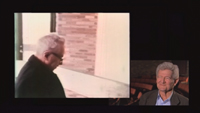
In a film made to mark its 75th anniversary, the Courant Institute of Mathematical Sciences turned to current faculty, postdocs, and students to express what the institute has meant to the many areas of mathematics and computing in which faculty have worked. Some commented on the big questions in researchers' minds today, and some looked to the future. A natural question to ponder is what institute founder Richard Courant (left) would have made of the anniversary symposium were he alive to attend. "Oh I think he would be delighted," said Peter Lax, whose career-long affiliation with NYU dates back to his 1947 bachelor's degree.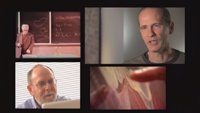
With Richard Courant presiding (upper left), Michael Shelley (upper right) commented on the shift in general research directions over the years: "The institute has been moving from classical partial differential equations to problems that have a fair amount of disorder. The problem is, how do you compute something like that? How does it affect the dynamics that you see?" Courant is "in many ways a science institute rather than a mathematics institute," Shelley said. "We use mathematics to do science." Charles Peskin (lower left), with his well-known model of the heart, knows about systems with disorder; with his immersed boundary method, he has shown how blood flow in the heart can be computed.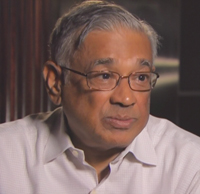
"The problems of the real world often can be translated into mathematics and solved, and the solution applied to the real world."---Srinivasa Varadhan
The Abel Prize, established in 2003, has been awarded three times to Courant faculty. Lax, the third recipient (2005), was followed by Varadhan (2007) and Gromov (2009), who spends half of his time at Courant, half at the Institut des Hautes Etudes Scientifiques.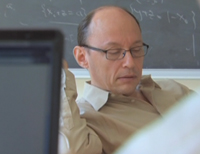
"We managed to keep a kind of fluid view of what work should be done in scientific computing to get the next generation of simulation capability out the door," said Leslie Greengard, whose five-year term as director of the Courant Institute ends in September. Looking to new challenges, he wondered, "Can we design new classes of mathematical tools that permit us to incorporate physical analysis and data and prior information in a way that is not being done now?" 
Courant postdoc Josef Sifuentes (lower right) works in a research group directed by Greengard. "I really get to choose my path and I get to choose the kind of things I research," Sifuentes said. "A scientist really wants to apply his expertise to several things rather than just staying in one little corner of the world."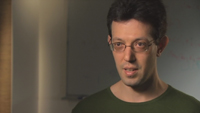
"We can understand a lot about geometric objects that the world cares about---let's say proteins or social networks or computer science. I do believe that this is of central importance to science, not only to mathematics."---Assaf Naor
"The goal of all really high-end applied science is not to make things as complex as possible, but to make things as simple as possible," said Andrew Majda. Commenting on progress at the Center for Atmosphere Ocean Science, which he founded, he ventured to say, "The piece of the holy grail related to the tropics is within grasp right now."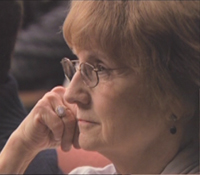
Margaret Wright arrived at the Courant Institute in 2001 as chair of the computer science department. "I would say that at Courant history is not a weight; it's an inspiration." Looking to the future, she described herself as "very optimistic, but then I work in optimization."

